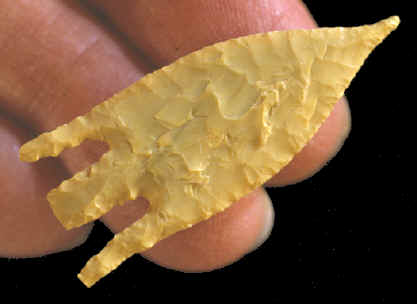|
FAN EARED POINT
NEOLITHIC PERIOD
5,000 B.C. TO 3,000 B.C.
SUB-SAHARA
AFRICA
COPYRIGHT MAY 31, 2004 PETER A. BOSTROM

CAST
#N-6
FAN EARED
POINT
NEOLITHIC
PERIOD
5,000 B.C. TO 3,000 B.C.
SUB-SAHARA,
AFRICA
The
Sub-Sahara region of Africa has produced some of the most
skillfully made arrow points. A multitude of
different types of have been found there. They are being recovered on sites
in Mali, Burkina Faso, Niger and Chad. One of the most artistic of these
is called a Fan-Eared point. The name is descriptive of the long narrow
barbs they have in varying lengths and angles. Fan-Eared points have
been reported from Mali and Niger.
Stone arrow heads from the Sub-Sahara region of Africa were made in almost
every imaginable shape. The most impressive (artistic) examples are also
the ones that required the most skill to manufacture. It's doubtful that
everyone making stone arrow points during the Neolithic period would have had this skill level. But a few
craftsmen seem to have taken stone arrow point making to the highest level
in this region of Africa. Some of the better examples have oblique
transverse pressure flaking. Others, like the Fan-Eared points have extremely long delicate "ears" or barbs and
"needle" points.
Fan-Eared points are so "delicately" made that it's
possible they were never meant to be used for hunting. Some of them may
have been made for special uses such as burial offerings to the dead. If
fan-eared points were domestically used, some of them have the appearance
of being too fragile for that purpose. An ear or point would
most certainly have broken after striking anything. Fan-Eared points seem suspiciously elaborate for normal use.
But that doesn't mean they weren't used for that purpose. There were
other cultures in the world that also made "fancy" projectile
points for hunting.
This Fan-Eared point is a classic example. It has a needle point,
recurved blade edges and deep notches that form long narrow outward
flaring barbs. It's also nicely flaked
on both sides and fairly thin. This point is made of a
beautiful piece of yellow chert of good quality and measures 1 11/16 inches (4.3 cm)
long and 1/8 inch (2.3mm) thick.
|
